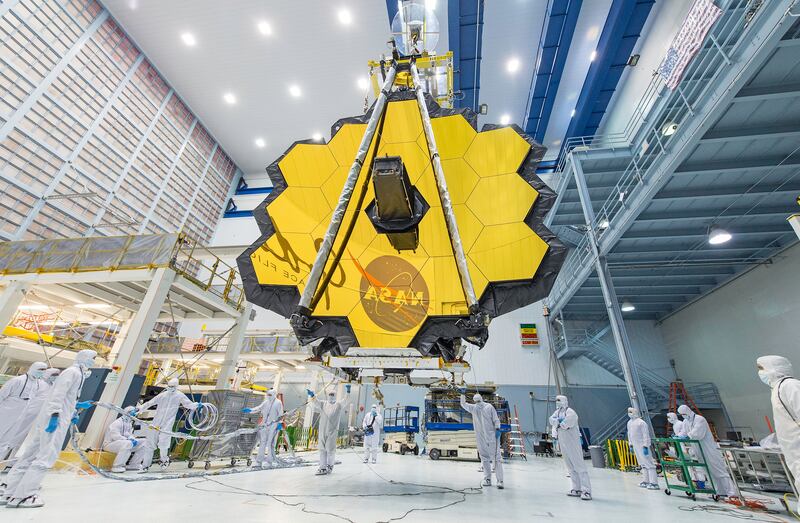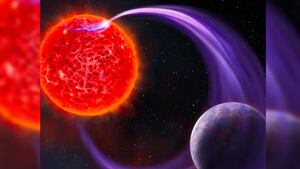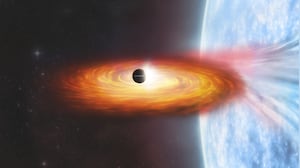Ten years ago, astronomers sifting through images from NASA’s Kepler space telescope spotted signs of something unusual: evidence of a very faraway “exoplanet,” orbiting weirdly close to its star. How close is close in space? In this case, barely farther than twice the diameter of the star itself (about 1.2 million miles).
This planet, later named Kepler-1520b, appeared to be trailing a long, cloud-like tail of dust and gas—a sign that it was disintegrating in the intense heat resulting from its tight, 15-hour orbit. By contrast, Earth’s orbit around the sun, at a distance roughly 100 times the sun’s own diameter, takes a leisurely 365 days.
Two more discoveries of so-called “disintegrating exoplanets” followed over the next five years. Two are proving to be especially provocative to the astronomy community. A pair of University of Arizona scientists have taken it upon themselves to figure out just how big Kepler-1520b and a fellow disintegrating planet called K2-22b really are.
The goal is to see how closely they match Earth. Even though the disintegrating exoplanets are really, really far away from us—800 light-years in the case of K2-22b, 2,000 light-years for Kepler-1520b—they might be our best way of modeling our own planet’s interior.
If the disintegrating exoplanets are similar in size to Earth, they might also be similar in composition. And as the layers of rock peel away on those faraway planets over millennia, the revelation of the planets’ insides could give us a glimpse of what Earth’s own insides might look like, too.
“One powerful aspect of disintegrating planets is that they naturally offer a way to learn about the crust, mantle or core of a planet,” Everett Schlawin, an astronomer who is one half of the University of Arizona team, told The Daily Beast.
It’s convenient that the disintegrating planets, by definition, orbit really close to their stars. After all, that’s why they’re burning away to nothing over a period of potentially hundreds of millions of years.
Those tight orbits mean the planets strike a nice contrast as they pass between us and the stars. That makes them easier than many other exoplanets for astronomers to identify in the crowded night sky. “Here we have nature taking planets apart and putting their interiors in front of bright sources of light for us to analyze!” Jason Wright, a Penn State astronomer, told The Daily Beast.
But there’s a catch. The disintegrating planets are usually often cloaked in the evidence of their own destruction: countless tons of dust that emulate the consistency of city smog, slowly sublimating into space.
For reasons astronomers don’t fully understand, the dust clouds seem to expand and contract as the disintegrating planets complete their quick loops around their stars. But the debris is pretty much a constant impediment to measuring the exoplanets.
Other astronomers and even NASA have tried before to assess Kepler-1520b and K2-22b. NASA for one concluded that both planets might be roughly the same diameter as Neptune, potentially making them around four times as wide as Earth. Other guesses came in somewhat smaller.
But many earlier estimates, including ones from NASA, absurdly lump the planets and their debris clouds together. It’s like measuring a burning hunk of firewood by holding a tape measure to the smoke being produced.
Schlawin and his co-author Keith Baka, a University of Arizona undergrad, wanted to do better. They aimed to “look through the veil of the debris trails in order to characterize the underlying planets,” they noted in a study not yet peer-reviewed that appeared online late last month.
Kepler-1520b and K2-22b are worth the effort. Of the roughly 100 billion planets in the Milky Way galaxy, including our own, there are just three we know of that are spilling their guts: the three disintegrating exoplanets.
That makes them potentially very valuable not just to space scientists, but to Earth scientists as well—geologists, to be precise. “It is, understandably, very hard to study the interior of planets directly,” Wright said. “We still don’t understand the interior composition of the Earth all that well, and it’s only a few miles away!”
Magma samples from active volcanoes might offer some clues about Earth’s internal makeup, but geologists are divided on their value, Wright pointed out. The magma might not reflect the overall composition of our planet’s enormous bulk.
Wright said a planet smaller than Earth might have a thin middle layer–a mantle–like Mercury does. That makes it a somewhat less valuable object of study for Earth geologists. By the same token, a planet that’s a lot bigger than our own is also a poor analogue for the purposes of studying Earth’s geology.
But if one or both of Kepler-1520b or K2-22b turns out to be close in size to Earth, then we might be able to use it as a scientific stand-in for our own planet. It’s kind of like when high schoolers dissect fetal pigs in order to understand human anatomy. “It’s a fantastic opportunity!” Wright said.
But measuring a planet from thousands of light years away is… hard. No currently deployed instrument can directly observe an exoplanet from Earth, so we make these observations indirectly—by pointing telescopes such as Kepler at stars, which are much easier to see.
Those observations don’t look like much to the naked eye. The stars Kepler surveyed between 2009 and 2018 are so far away that the resulting images look like whitish dots on a field of mostly black. But the brightness of each dot can be telling, especially as the brightness changes in separate observations.
When you look at a star from far away, it gets brighter then darker then brighter again as a planet or other object passes between it and you. This so-called “light curve flux dip” data is “rich with information,” according to NASA. “By measuring the depth of the dip in brightness and knowing the size of the star, scientists can determine the size or radius of the planet.”
Rifling through the data Kepler gathered in its nine years of operation, Schlawin and Baka identified 32 indirect observations of Kepler-1520b and 19 indirect observations of K2-22b.
Schlawin and Baka blended several mathematical techniques—a “Gaussian noise component,” a “Raleigh astrophysical component,” a “Hamiltonian Markov Chain”—to make sense of the light curves of the two disintegrating planets’ stars and thus better measure the planets themselves.
It’s all very technical. The upshot is that Schlawin and Baka tried really hard to measure the exoplanets themselves rather than the planets plus their dust clouds.
Schlawin and Baka managed their expectations. They didn’t expect to come away with definitive and detailed dimensions of Kepler-1520b and K2-22b. Instead, they hoped to to estimate their maximum possible size on a range of possible dimensions.
Their results were encouraging and surprising. Both disintegrating exoplanets seem to be no bigger than 6,800 miles in radius. That would make them much smaller than Neptune with its 15,300-mile radius, but somewhat bigger than Earth, which has a radius just shy of 4,000 miles.
The surprise, however, was that Schlawin and Baka’s closer analyses more or less matched the results of some of the previous, rougher estimates. “Neither produced a result on the maximum radius not already obtained by previous studies,” they wrote about their own assessments. The previous estimates apparently got lucky.
In any event, thanks to Schlawin and Baka’s work, we’re beginning to zero in on accurate measurements of Kepler-1520b and K2-22b. It’s looking more likely that one or both of the planets might end up being a reasonably good stand-in for Earth. One that’s falling apart.
Finding a disintegrating Earth analogue is obviously the most tantalizing scientific prize in this undertaking. But it’s not the only one. Even if the disintegrating exoplanets ultimately prove to be poor matches for Earth, there’s still a lot they can teach us—once we finally, definitively measure them.
“The size of these planets can help derive other properties, such as the lifetime of the system, planet density, surface gravity, composition and other dynamics of the system,” Schlawin and Baka wrote. “That can help the scientific community better understand systems like these and better model planetary systems as a whole.”
Either way, there’s a lot more work for Schlawin and Baka and other astronomers to do. The pair plan to refine their model over time to get better and more narrow estimates on the planets’ sizes.

The James Webb Space Telescope's enormous mirror being worked on by NASA engineers.
NASAAnd there should be better raw data on the way as well. Wright pointed out that NASA’s new James Webb Space Telescope, slated to launch later this month, might be able to observe Kepler-1520b and K2-22b themselves, rather than observing their stars in order to indirectly observe the disintegrating planets.
The new telescope could give astronomers their first clear, direct views of Kepler-1520b, K2-22b and other exoplanets, stripping away the fog of distance and darkness that obscures their most interesting qualities.
The James Webb Space Telescope—provided it launches successfully—could help us settle, once and for all, the argument over the disintegrating planets’ size and suitability as Earth stand-ins.
After that, it could help us shoot the first clear images of those planets’ biggest secrets. Their rocky guts.







